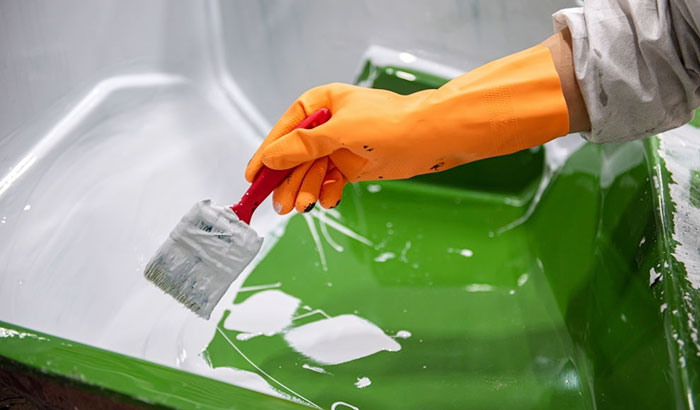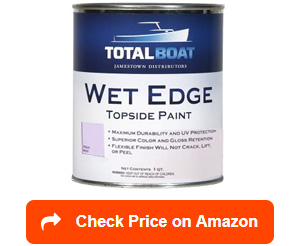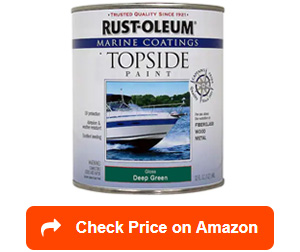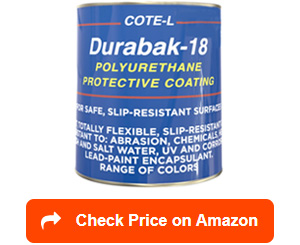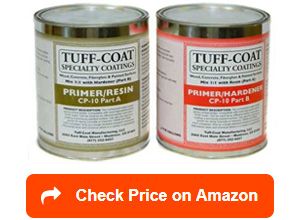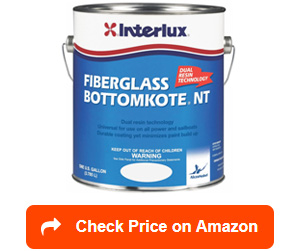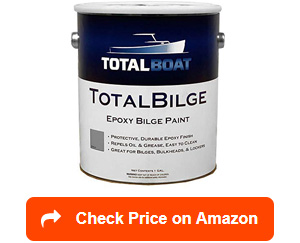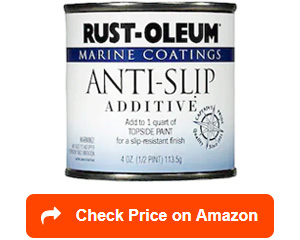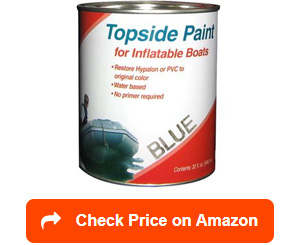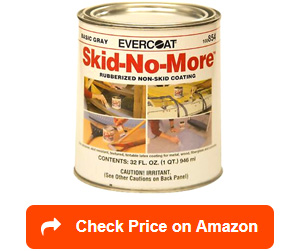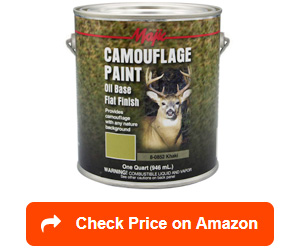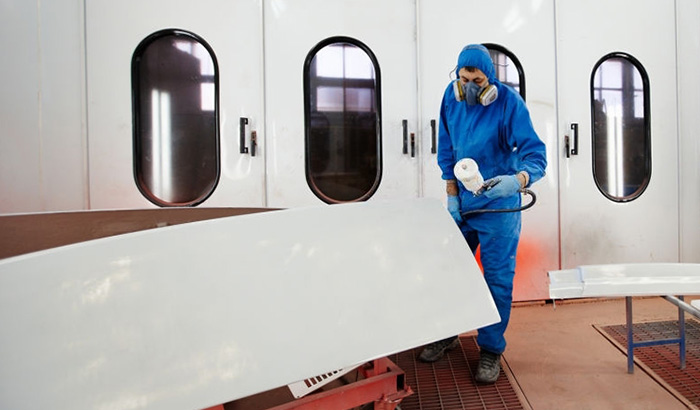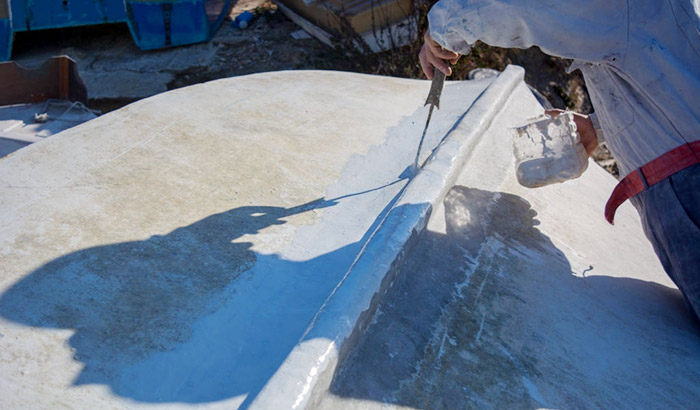Of all boat surfaces, many would agree that painting over fiberglass is among the most difficult. However, the usual reason why so many people fail at painting their fiberglass water vessels is that they are not using the right paint for the job. In this case, you need to look for a paint for a fiberglass boat that can produce professional-looking results.
Before you put brush to paint, ensure that the one you are using can adhere to a fiberglass surface. Pick the best paint for a fiberglass boat hull as much as possible as using the wrong kind will only cause the paint to crack and peel after a short while.
If you already know how to paint a fiberglass boat yourself, the next thing to do is choosing the right freshwater and marine paints for fiberglass boats. You can use this article as a guide when shopping as it comes with a few recommendations and other important pieces of advice for buying the right product.
Contents
- Best Paint for Fiberglass Boat Reviews
- 1. TotalBoat Wet Edge Topside Fiberglass Paint
- 2. Rust-Oleum Marine Coatings Topside Paint
- 3. Durabak 18 TEXTURED Non Slip Deck Paint
- 4. TUFF Coat CP-10 Primer
- 5. Interlux YBB379/1 Fiberglass Bottomkote NT Paint
- 6. TotalBoat TotalBilge Paint
- 7. Rust-Oleum Marine Anti-Slip Additive Coating
- 8. Inland Marine USA Topside Paint
- 9. FIBERGLASS EVERCOAT 100854 Skid-NO-More Coating
- 10. Majic Paints 8-0852-2 Camouflage Paint
- Who is This for?
- Factors to Consider When Buying a Paint for Fiberglass Boat
- Advantages and Disadvantages of Using a Paint for Fiberglass Boat
- Care and Maintenance
- Frequently Asked Questions
- Conclusion
Best Paint for Fiberglass Boat Reviews
1. TotalBoat Wet Edge Topside Fiberglass Paint
The thing that impressed me about the TotalBoat Wet Edge marine paint is that it is effortless to apply. Straight out of the can, it already has a perfect consistency. It does not need a thinner. Just mix the contents thoroughly. It was so easy to use that I only needed several brushes to cover my 14-inch sailboat with several coats.
I am also glad that it has several choices for colors. I was worried at first because I needed three different colors for a project, and I did not want to use different brands if I can help it. I was pleasantly surprised to discover that all the colors I needed were already in the 21-color lineup for this brand.
This paint is not just for fiberglass, which I appreciated because after I painted my boat, there was still a lot of product left over. It can also adhere strongly to fiberglass and on wood and metal. I used the leftover paint to give my hardwood front door a new coat and it was surprisingly good.
Aside from how good it looked on my front door, I am also satisfied with its durability. Since it is marine paint, I did not doubt that it can protect whatever it covers from rain and moisture. However, it was also abrasion-resistant. I tested it by attempting to scratch the second coat as soon as it cured and there is not even a mark.
A word of warning, though. For an excellent finish, it is also crucial to compromise on the drying and curing time. It took an entire week of on-and-off painting to finish my small sailboat. If you plan to use this paint, make sure to set aside enough time for it.
- Almost effortless application
- Lots of colors to choose from
- Can work on different surfaces aside from fiberglass
- Highly resistant against abrasion
- Resistant to saltwater, UV rays, and chemicals
- Has a long drying and curing time
Despite the painfully slow drying time, the wait was well worth it as this top paint for fiberglass canoe will provide a glossy and vibrant finish that is highly damage-resistant.
2. Rust-Oleum Marine Coatings Topside Paint
Rust-Oleum has always been one of my go-to brands when it comes to marine boat paint. One reason why I like this paint is that I only needed around 2 quarts of the stuff to paint my small sailboat with a couple of coats, and I did not even need to thin it at all. I highly recommend it for those who have tight budgets.
Another reason why I like this marine polyurethane paint for fiberglass is that it applies easily onto fiberglass and other kinds of surfaces. It works great as I just needed to use one brand to paint my entire boat. I used this paint not only on the hull but also to paint the wooden seat and interior sidings.
I am also glad that it dries to the touch quite fast. After laying down the first coat, it was already dry in under an hour. I managed to finish painting my boat using three coats in just one weekend afternoon. It is good to use if you only have limited time in your schedule for your personal projects.
This brand has never failed yet to impress me with its high-gloss finish. Even without applying a clear coat, this paint looked slick and shiny. Also, with proper care and maintenance, the finish will remain glossy and the color will stay vibrant for years to come.
Now, as mentioned earlier, I liked how fast this paint dries, but curing is another thing. This product will take a couple of days to cure, longer if it is a bit cold where you live. Moreover, while it is still in the process of curing, the paint is susceptible to scratches.
- Wide coverage with just a small amount of paint
- Works for wood and metal surfaces apart from fiberglass
- Dries in just an hour or two
- Provides a high-gloss finish that can last for a long time
- Highly resistant to abrasion and extreme weather conditions
- Takes a long time to cure
All in all, the Rust-Oleum marine paint is one of the best boat paints that I have ever had the pleasure to use. In my opinion, the rather long curing time is a fair compromise for the quality of the finish you will get.
3. Durabak 18 TEXTURED Non Slip Deck Paint
Aside from not having a big enough budget to hire a professional boat painter, I genuinely love to work on my own boat. It is the reason why when I was looking for a paint for a fiberglass boat floor, I got a gallon of Durabak-18. It only has one part, so just stir the contents of the can before using without adding anything else.
I don’t consider myself a tree-hugger, but I do try to do my part to help the environment whenever I can. So, when I learned that this deck liner uses recycled rubber to provide the textured finish, I did not hesitate to get this for my boat. Aside from helping the environment in my own small way, the grit provided was excellent.
Speaking of the textured surface, I was happy with the results I got. Thanks to the bit of recycled rubber, my boat’s deck is completely non-slip even when completely drenched with water. The finish is also durable enough that you need to try hard to leave a visible scratch on the surface.
Now, in case you somehow accidentally cause a bit of the coating to peel off, it is an easy fix. This paint easily bonds to itself even without extensive surface preparation. Just paint over the damaged area and it would look like nothing happened.
Here’s the problem that I had with this paint, and it stemmed from me not knowing how to apply textured deck coating properly. I first used a regular paint roller to apply it but all I did was push the grits with the roller. I did not know that you needed to use a special roller.
- Simple to use without requiring any mixing
- Contains recycled materials
- Provides a completely non-slip surface
- Can bond to itself easily
- Bonds to all kinds of surfaces with little preparation
- Needs a special stipple roller for the grit to distribute evenly
With the right equipment, which is just a different type of roller brush, you can make the deck of your fiberglass boat or any surface for that matter, non-slip.
4. TUFF Coat CP-10 Primer
This product is not just your ordinary primer. It is also an epoxy sealant and one option for the best primer for fiberglass boats available. I used it on my decade’s old fiberglass boat and it made it look and work like new. There were a couple of small leaks on the surface that I was not able to find in the past and it took care of it like it was nothing.
It is so easy to use that you don’t even need any specialized equipment. Just mix equal parts of the resin and the hardener then pour or brush it over the surface. It self-levels so it will always come out smooth. Moreover, the tins are twice the size that they need to be so you can just pour the contents of A into the can of B for mixing.
This sealant leaves behind a sort of rubbery texture, so you can also use it as a deck coating. It also works great for flooring because it is completely waterproof. With that, any spilled drink or food on the surface will not leave a stain. You can just hose off any kind of a mess.
I am also happy with its drying and curing time. I applied the epoxy primer late in the afternoon because it took me the entire day to clean the surface of my boat completely. By the next morning, the entire surface was already dried and cured. It may take a bit longer if you live in a colder climate, but it will not take more than a day at the longest.
As for drawbacks, I can’t find anything major. However, I think people who won’t be using the entire tin for their project would appreciate it more if the kit came with a measuring/mixing cup. It would have been better if you would not be using the entire quart.
- Seals and protects the surface
- Dries and cures overnight
- Provides a waterproof finish
- No VOCs and fumes
- Durable and can take a hit
- No mixing tub included
All in all, I do not have anything bad to say about this product. It did what it promised it would do, and more.
5. Interlux YBB379/1 Fiberglass Bottomkote NT Paint
One impressive fact about this product is that it provides the kind of durability you can expect from hard bottom paints. What is even better is that it has self-polishing and antifouling properties. You are getting the best of both worlds and without making too much of a compromise from both sides.
As mentioned earlier, this paint auto-polishes itself the more you cut your boat through the water. It means that it will look much better after a couple of weeks compared to when you first applied it. It helps the boat cut through the water more efficiently, thus improving the craft’s overall functionality.
Another nice feature of this paint is how fast it dries. It also boasts of a quick launch time. I painted the bottom of my boat in the morning and by late afternoon, it is already in the water. No need to wait for the paint to cure as it will continue curing even when submerged underwater.
Aside from the other features mentioned above, this paint also has the added benefit of being able to adhere to various materials. It works well on fiberglass, but it can also adhere to painted surfaces (prepared), wood, and metal.
The only problem that I encountered with this paint is that its finish does not look uniform. Some parts are glossy while there are also large patches in the places where the paint is matte.
- Comes with all the benefits of hard-bottom and ablative paints
- Self-polishes to reduce drag through the water
- Fast-drying
- Can adhere on almost all boat surfaces
- Effectively prevents bio-organisms from attaching to the hull
- Not glossy throughout
Despite that, you will be receiving more than just one type of paint when you get this product. With just that fact alone, it is safe to say that you can get your money’s worth.
6. TotalBoat TotalBilge Paint
Since it is a paint intended for use on the bilge of a boat, it is only right that this epoxy paint should be quite hard and impact-resistant. If you are like me, then you probably always drop your tools into the bilge. Most of those tools can knock out a person cold, so I am happy with this paint as it has not cracked yet.
Aside from being extremely impact-resistant, it also resists different chemicals, most of which are caustic. It is suitable for the bilge of a boat because those are the kinds of nasty stuff that you will often find in that part. This specific part of the boat is also that which you would not like to find any sort of corrosion, and the product can help with it.
Another reason why it is the ideal paint for the bilge is its light color. You can get it in either light grey or white. With that, I can easily spot any foreign object that accidentally fell into the bilge, which can potentially cause damage to the engine and other components. It also helps in spotting chemicals or fuel that leaked into the bilge.
Despite being a specialty paint, it was surprisingly easy to use. It is just like using regular paint without requiring additional preparations.
Take note, though, that it is specifically for the bilge of a boat, a place that is not visible from the outside of the boat. With that said, it does not provide a necessarily good-looking finish, so you might need to choose another paint if you want to cover the exterior.
- Hard and durable
- Can resist various chemicals
- Light-colored, so you can find accidentally dropped items easier
- Easy to use
- High gloss finish and easy to clean
- Only appropriate for boat bilges and may not look good elsewhere
Overall, this paint does its job. It works more like a protective feature from the inside instead of working cosmetically.
7. Rust-Oleum Marine Anti-Slip Additive Coating
When I painted my boat last summer, I was hesitant to purchase a separate deck paint. My problem is that it is difficult to find a deck paint that is the same color, or at least similar, to the paint I used for the rest of the boat. This was not a problem with this product as I just need to mix it with the paint I was using.
Using this additive is also a more cost-efficient option compared to purchasing a separate deck paint. It is especially true if you are using a specific color for your boat. You must tint the expensive deck paint just so it would match. It works great if you have a limited budget for your boat renovations.
Unlike other anti-skid deck paints, walking on the finish provided by this product is not like walking on gritty sandpaper. It can provide your feet with a surface that is easy to stand and walk on. You will not feel awkward walking on your boat anymore, even if it is made of fiberglass.
You also do not need to worry about whatever kind of paint you are using. This additive can work with both latex and oil-based paints that are notorious for dissolving other additives. Any kind of paint that you have on hand will work.
Some people might find a problem with the visibility of the finish left behind by this product. In the case of my boat, you can tell where the interior paint ended and where the non-slip paint started. Discreetness is not one of this product’s strong points.
- Can be mixed with latex and oil-based paints
- More cost-effective than buying actual skid-resistant paint
- Provides a surface that is comfortable to walk on barefoot
- Applicable on all kinds of surfaces
- Lasts just as long as the paint it’s mixed with
- Not that discreet – You can easily tell which parts it was used on.
However, high visibility is not that big of an issue, and knowing where you can stand and walk on can be handy most of the time. This product does what it is supposed to do well, making it one of the best boat fiberglass floor paint options you can buy right now.
8. Inland Marine USA Topside Paint
Do you have an inflatable boat? If so, then try this amazing topside paint. It is like you are putting another layer of rubber over the surface of your inflatable water vessel. It can expand with the vessel when it is hot outside and contract when it is cold. Even when you deflate the craft, the paint will remain stuck on the surface.
It is also highly resistant to the sun’s UV rays. Other paints will dry up and crack when left under the sun for too long. It is not an issue with this paint. Unlike decals and regular paint, it will not crack or peel off the surface of the inflatable vessel. I applied it on my dinghy a couple of months ago and it is still intact.
Aside from improving the appearance of an inflatable boat, it can also improve the airtightness of the vessel. As I said earlier, using it is like adding another layer of rubber over the surface of the vessel, which works to increase the integrity of the boat.
Another thing that impressed me about this boat is how long its color lasts. I used the international orange color on my boat, and it has been months since I painted it, but the color remained bright and vibrant. If it has indeed faded, I cannot notice it.
Now, I have any huge complaints about this product. However, if I must point out something that may be problematic for some people, it would be the limited color palette.
- Highly elastic
- Improves the airtight integrity of the inflatable
- Has high UV-resistance
- Colors remain vibrant for years
- Needs minimal surface preparation
- Limited color options and cannot be tinted for color adjustments
Honestly, I can’t find anything terribly wrong with this paint. For all intents and purposes, it works well for the job it was made for, so it might not work as well for other surfaces.
9. FIBERGLASS EVERCOAT 100854 Skid-NO-More Coating
One thing I noticed about inferior non-skid coatings is that they were so rough that I have lost quite a bit of skin from my knees whenever I trip and fall. This product is significantly different. Although it provides a great, non-slip coating, it is not too coarse. You can walk barefoot on the surface and it will not hurt at all.
I am also impressed that you can easily apply it using just an ordinary paintbrush. You can only use a brush to apply this paint. Due to its thin viscosity, roller brushes will only push the grits, causing uneven coverage. So, if you are painting a large boat, then you need to use a wide brush.
Although the application can be tedious, the payoff is that this non-skid coating can last for many years. If you prepared the fiberglass surface properly, this coating will strongly bond to it. It has been months since I painted the deck of my fiberglass sailboat, but I cannot even find any cracks, peeling, or faded areas no matter how hard I look.
Speaking of surfaces, it is not just for fiberglass. I also used it on my aluminum boat and it went on without any hitch. The only preparation I did was clean the surface thoroughly and used acetone to get rid of any oils. There is no need to sand or scour the surface to paint.
However, be warned that it only comes in one shade of color – that is, gray. If you want to change the color, then buy two tins of a special paint tint and those are quite expensive.
- Provides a non-slip surface that is comfortable to walk on
- Easy to apply using a brush
- Highly durable and lasts a long time
- Usable straight of the can – It just needs a bit of mixing.
- Usable in almost all kinds of materials
- Only comes in a not-so-appealing gray color
Although unfortunately, this product only comes in one color, the important thing is that it provides a good, non-slip surface and that it can last for years. These reasons prove that it is an excellent option for suitable paints for a fiberglass boat deck.
10. Majic Paints 8-0852-2 Camouflage Paint
If you like to go fishing in rivers, you will need a good camo paint job for your boat. In that case, Majic Paints camouflage paint comes highly recommended. I used it on my fiberglass canoe and the colors helped give the vessel a matte, non-reflective finish that made it blend into the background even more.
This paint is not just for refinishing fiberglass boats. I also used it on my deer blind and it helped prevent the metal tube frame from rusting. It also kept the wood from rotting, which is a nice additional benefit. However, if you will be using it on metal, I suggest that you first apply a coat of self-etching primer.
Although this paint is not waterproof, it is highly water-resistant. It came in handy when I was painting my deer blind because I was getting tired of replacing the wooden boards every other season. This paint not only made it easier to hide my deer blind, but it also protected it from the harsh environment.
I also liked how this paint does not require that much surface preparation, especially if you are painting a fiberglass surface. When I painted my boat, the only thing I did was clean the surface thoroughly and sand the surface lightly. The paint had no problem adhering to the surface, and so far, it has not chipped or peeled yet.
Now, I do have one major problem with this product – it dries slowly. I finished painting my boat on a Saturday and by Sunday late afternoon, the paint was still a bit tacky. All in all, drying and curing took at least a week.
- Provides camo-accurate colors for any background
- Contains rust inhibitors
- Water-resistant and resistant to harsh weather and environments
- Adheres to various surfaces
- Does not require extensive surface prep
- Dries slowly
Even though the paint took an awful lot of time to cure, it is still an impressive choice for the best marine paint for fiberglass. It is highly recommended mostly due to its durability and how effective it is at camouflaging objects.
Who is This for?
As the name suggests, these paints are for fiberglass boat owners. These boats are usually small, like sailboats, kayaks, canoes, and the like. However, there are also larger boats that use fiberglass, but not as a main component.
Factors to Consider When Buying a Paint for Fiberglass Boat
When you are out shopping for a paint to use on your fiberglass boat, do not just get the first tin that you see. Here are some of the crucial features and qualities you should seriously consider:
Durability
Once cured, the paint should be able to endure impacts and abrasive forces. A good paint should withstand years of wear so it can be considered worth your money.
Ease of Use
The paint you buy should be usable straight out of the can. No additives or extensive mixing are needed unless, of course, you are using epoxy-based paint. Also, the paint should be easy to apply regardless if you are using a brush, roller, or spray gun.
Coverage
Ideally, a gallon of the best fiberglass boat paint should be enough to provide several coats for a small to medium-sized boat. The paint should not be so thick that you will only have enough for painting a fiberglass canoe.
Marine or Freshwater?
Take into consideration what kind of environment you are taking your boat out to. If you are more into going out to sea and other saltwater bodies, you need to use marine boat paint as those are the ones that are resistant to the corrosive effects of saltwater.
Now, if you are more into rivers and lakes, you can still use marine paint, but that would be overkill, so just use a regular boat paint made for freshwater environments.
Drying and Launch Time
Your time is important and you should not waste it waiting for paint to dry. Ideally, the boat paint you use should be dry to the touch in just a couple of hours so you can put on the additional coats.
Regarding the launch time, the paint should be dry enough after 8 hours or so, with a day being the longest, before you can take it to the water.
Advantages and Disadvantages of Using a Paint for Fiberglass Boat
Advantages:
- Provides additional protection for the fiberglass surface
- In the case of non-skid paints, they provide a non-slip surface to make walking on the deck safer.
- Makes the boat more visible – It is important in case of emergencies.
- Makes your boat more aesthetically pleasing
Disadvantages:
- Some paints require extensive surface preparation.
- Some fiberglass paints dry rather slowly – You can even find those that need up to 2 days to cure completely
Care and Maintenance
Even though fiberglass boat paint is UV-resistant, you should still not deliberately expose it to sunlight as much as you can. With that said, you need to invest in a good boat cover to prevent direct sun exposure.
Also, if possible, put your boat on a trailer if you will not be using it for a couple of days to a week. It can prevent the bottom paint from fouling while reducing the paint’s exposure to water.
If you have any paint left over after your project, replace the lid and make sure that you put it on tightly. Store the can somewhere cool and away from direct sunlight.
Frequently Asked Questions
Can you Paint a Fiberglass Boat with RUST-Oleum?
Yes, painting a fiberglass boat with Rust-Oleum is possible. You just need the right paint for the job. Just make sure to read the label to be sure that the paint you get can adhere to fiberglass.
How to Remove Paint from a Fiberglass Boat?
The easiest way to remove old paint from fiberglass boats is to use a fiberglass paint remover. Avoid using the regular paint stripper as it would also eat away at the fiberglass surface.
Work on small areas at a time to prevent the paint remover from drying completely. Just apply a bit of paint remover and wait for the paint to blister, then scrape it away using a dull plastic scraper.
Can I Use Spray Paint on a Fiberglass Boat?
Yes, but it is only practical if you will only be using it for touch-ups and repairs. It would be too expensive to use fiberglass boat spray paint cans on a boat. On the other hand, if you are thinking of using a spray gun, you will need to thin the paint down to the right consistency to keep it from clogging the nozzle.
Conclusion
A lot of people mistakenly think that it is difficult to paint on fiberglass surfaces and the reason why they say that is they did not use the right paint. If you want to get your desired results, then get a suitable paint for a fiberglass boat that you can afford.
Don’t worry, even though the best paints are somewhat expensive, they will pay for themselves in the long run. The reason is that they are durable and resistant to external forces.

